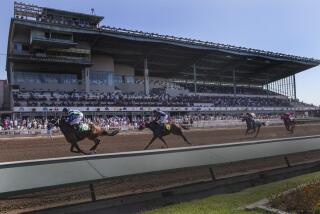Hay, Doc! : Equine Vet’s Work Ranges From Checkups to Surgery
- Share via
YORBA LINDA — The buckskin quarter horse stands shakily on a painful left front hoof, his big brown eyes fixed trustingly on Dr. Paul Wan.
“You’re soooooo good,” Wan says soothingly to 8-year-old Ernie, who is becoming agitated as the 32-year-old veterinarian injects a tranquilizer into the animal’s neck.
Ernie, growing wobbly, is led into a circular operating room where Wan will perform laser surgery on the injured hoof.
“What we need to do is keep him comfortable,” Wan says as he prepares for the surgery, changing into surgical clothes, meticulously scrubbing his hands and putting on a pair of protective goggles.
But the surgery itself seems easy compared to the Herculean effort it takes to get the 1,075-pound animal ready for the 20-minute procedure.
Ernie is given anesthesia and begins to fall to the ground as he loses consciousness. Wan and two assistants, using all their strength, stand the sleeping horse against a padded wall, then ease him gently to the ground. His legs are then placed in hobbles and he is lowered upside down onto the operating table.
Ernie is placed on a ventilator and will not breathe on his own until after the surgery. A device called an ultrasonic Doppler is wrapped around his tail to monitor his heartbeat throughout the procedure.
“Once we take over in anesthesia, there is very little that can go wrong,” Wan says. “We take control of everything and don’t leave anything to chance. We don’t even rely on the horse to breathe.”
The operation, which costs more than $1,000, involves severing some nerves in the horse’s hoof to deaden the pain he had been experiencing. The surgery is a last resort, since corrective shoes and other methods have not solved the problem, Wan says.
The operation is one of dozens that Wan has performed since March, when he became a partner at Equine Veterinary Associates, on the Rocking Ranch in a rural part of Yorba Linda. He is one of about 50 veterinarians who practice equine medicine in Orange and eastern Los Angeles counties, and is one of the few board-certified veterinary surgeons in Orange County.
It is here that the Chino resident seems to have found his calling. Most days, he drives his white Ford pickup to stables throughout the county, visiting equine patients, treating everything from pneumonia to colic, a common equine digestive disorder.
It’s a job, Wan says, for those who like working outdoors and being on their own.
“I like the independence. You go out there and it’s just you and the horse. You never know what you are going to do one day to the next, and there is no set schedule.”
*
When he’s not in the operating room, Wan might visit as many as seven stables in a single day, tending sick or injured horses or performing routine checkups. His patients range from racehorses to newborn foals.
“I like working with the foals,” Wan says. “They are pretty silly with their long, gangly legs. Really funny looking.”
While he enjoys his work on the road, it is in the operating room where Wan feels he is at his best and can use the training he received during his three-year surgical residency at the University of Tennessee.
“You want to have a mellow surgeon and Dr. Wan is very mellow,” said Jim Tice, owner of Rocking Ranch.
The operating room is equipped with white padded walls and a soft cork floor to lessen the chance of injury to horses that get out of control once they awaken after surgery.
A successful recovery, Wan says, is the best part of the job.
In contrast, the worst part is when a horse doesn’t have a chance of recovering and has to be destroyed. Wan says this is the part of the job he dreads the most and something that must be handled delicately.
“We have to do it more often than we like to,” he says. “You need to talk to a client and make sure it’s what they want. They need to make sure they don’t prolong the horse’s suffering and are not keeping the animal alive for themselves.”
*
Recently, Wan was forced to euthanize a 29-year-old quarter horse named Topaz that was suffering from a chronic neurological problem and was no longer able to stand. The horse had fallen into a ravine in Yorba Linda and was lifted out by a tow truck.
A few weeks after that fall, Wan had to give the tearful owner the grim prognosis. He suggested she might want to walk away while the horse was given a fatal dose of anesthesia, but she refused. Instead, she held her horse’s head until he died.
“You try and explain exactly what is going on,” Wan says. “If the owner is educated in what is going on, they can handle it a little better.”
Although most of his days are spent around horses, Wan is not an equestrian. He has only ridden a horse once in his life and said he doesn’t have a big desire to do it again.
“When I first got to vet school, I was leaning toward treating dogs and cats,” he says.
“But the more I learned about horses, the more I liked them. I find them easier to handle, more predictable. Most of them are pretty loyal and very responsive to their owner. It amazes me that such a large creature can respond to owners the way that they do.”
More to Read
Go beyond the scoreboard
Get the latest on L.A.'s teams in the daily Sports Report newsletter.
You may occasionally receive promotional content from the Los Angeles Times.










